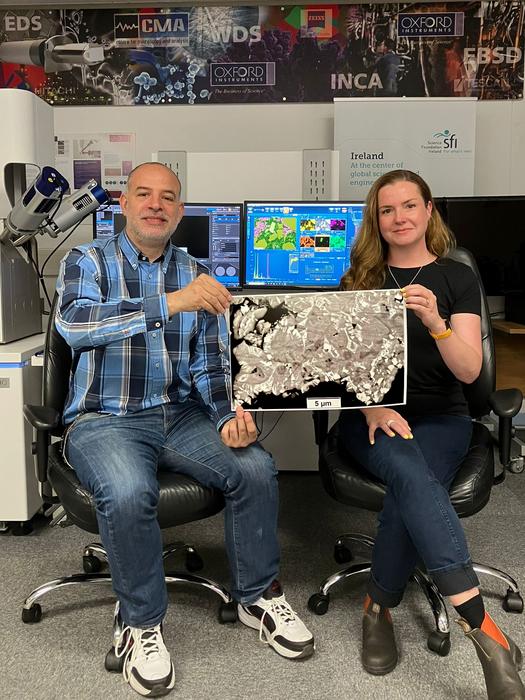In a ground-breaking study, researchers from Trinity College Dublin have unveiled that myriad, intricate factors influence the genesis and chemistry of bastnäsite and rare earth carbonates, which are critically needed for today’s tech industry and its hardware outputs.

Credit: Juan Diego Rodriguez-Blanco
In a ground-breaking study, researchers from Trinity College Dublin have unveiled that myriad, intricate factors influence the genesis and chemistry of bastnäsite and rare earth carbonates, which are critically needed for today’s tech industry and its hardware outputs.
Their work, just published in international journal Global Challenges, unveils a newly acquired depth of understanding that had previously been unexplored in this field. In combination, the findings mark a significant advancement and promise to reshape our understanding of rare earth mineral formation.
Crucially, as global demand for rare earth elements continues to rise – largely to satisfy the growing demand for the mobile phones, batteries and speakers in which they are put to work – insights from this research could have far-reaching implications and various industrial and environmental applications.
What have the researchers found?
Contrary to prior assumptions, the new research reveals that the formation of bastnäsite – the top rare earth mineral exploited by industry – is not a straightforward process but instead one driven by a very complex interplay of multiple factors.
The experimental approach involved studying the interaction between solutions containing multiple rare earth elements and common calcium-magnesium carbonate minerals like calcite, aragonite and dolomite (which are ubiquitous in nature) under hydrothermal conditions ranging from 21 to 210 °C. The team tested two solution types: one with equal rare earths concentrations, and another one simulating concentrations more typical of the usual hydrothermal fluids found on Earth.
The findings show that when the common calcium-magnesium carbonate minerals react with rare earth-rich fluids, they change their structures and chemical compositions, forming a series of rare earth-bearing minerals with exotic names like lanthanite, kozoite, bastnasite and cerianite, with very complex chemistries, shapes and textures.
Particularly interesting is that different solution types lead to distinct outcomes: For example, equal-concentration solutions promote kozoite and bastnasite crystallisation, maintaining similar rare earths ratios in solids and solutions.
Conversely, hydrothermal fluids mimicking the ones found on Earth result in rare earth-bearing minerals with varied elemental distributions – and some of these even go through decarbonation processes due to the formation of rare earth oxides.
Ultimately, the experiments showcase the extremely dynamic nature of rare earths mineral formation, with unstable minerals transforming into more stable ones over time, and sometimes developing textures impacted by adjacent mineral reactions that further underscore the complexity of the process.
What are the potential implications?
The implications of this research extend far beyond the laboratory. Understanding the complex processes involved in bastnäsite formation has profound implications for geologists and industry alike. The research demonstrates that the development of advanced simulation models is strongly needed, allowing scientists to replicate natural conditions and explore alternative methods for mineral extraction or synthesis.
While challenges remain, the insights from this study open the door for new experimental protocols to understand the fate of rare earth elements in complex geological ores where they concentrate.
Melanie Maddin, PhD researcher in Geology in Trinity’s School of Natural Sciences, is the lead author of this study. She said: “These findings challenge the models previously applied to rare earth mineral formation. Our research highlights the dependence of crystallisation pathways, mineral formation kinetics, and chemical texture on a myriad of factors, including rare earth concentrations, ionic radii, temperature, time, and host grain solubility.”
Juan Diego Rodriguez-Blanco, Principal Investigator of the research group and Professor in Trinity’s School of Natural Sciences, emphasised the significance of these findings in understanding not only bastnäsite formation but also the broader field of rare earth mineralogy.
Dr Rodriguez-Blanco, a funded investigator in iCRAG (Science Foundation Ireland Research Centre in Applied Geosciences), said: “This study opens new avenues for research in geochemistry and mineralogy, paving the way for a more comprehensive understanding of mineral formation processes.”
Journal
Global Challenges
DOI
10.1002/gch2.202400074




